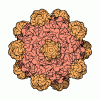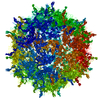[English] 日本語
 Yorodumi
Yorodumi- PDB-6nz0: Cryo-EM structure of AAV-2 in complex with AAVR PKD domains 1 and 2 -
+ Open data
Open data
- Basic information
Basic information
| Entry | Database: PDB / ID: 6nz0 | |||||||||
|---|---|---|---|---|---|---|---|---|---|---|
| Title | Cryo-EM structure of AAV-2 in complex with AAVR PKD domains 1 and 2 | |||||||||
 Components Components |
| |||||||||
 Keywords Keywords | VIRUS / AAV / AAVR / receptor / coreceptor / KIAA0319L / PKD / parvovirus | |||||||||
| Function / homology |  Function and homology information Function and homology informationproacrosomal vesicle fusion / response to auditory stimulus / symbiont entry into host cell via permeabilization of host membrane / host cell nucleolus / flagellated sperm motility / T=1 icosahedral viral capsid / receptor-mediated endocytosis of virus by host cell / trans-Golgi network / neuron migration / cytoplasmic vesicle ...proacrosomal vesicle fusion / response to auditory stimulus / symbiont entry into host cell via permeabilization of host membrane / host cell nucleolus / flagellated sperm motility / T=1 icosahedral viral capsid / receptor-mediated endocytosis of virus by host cell / trans-Golgi network / neuron migration / cytoplasmic vesicle / clathrin-dependent endocytosis of virus by host cell / Golgi membrane / virion attachment to host cell / nucleolus / structural molecule activity / Golgi apparatus / membrane / plasma membrane Similarity search - Function | |||||||||
| Biological species |  Homo sapiens (human) Homo sapiens (human) Adeno-associated virus - 2 Adeno-associated virus - 2 | |||||||||
| Method | ELECTRON MICROSCOPY / single particle reconstruction / cryo EM / Resolution: 2.4 Å | |||||||||
 Authors Authors | Meyer, N.L. / Xie, Q. / Davulcu, O. / Yoshioka, C. / Chapman, M.S. | |||||||||
| Funding support |  United States, 2items United States, 2items
| |||||||||
 Citation Citation |  Journal: Elife / Year: 2019 Journal: Elife / Year: 2019Title: Structure of the gene therapy vector, adeno-associated virus with its cell receptor, AAVR. Authors: Nancy L Meyer / Guiqing Hu / Omar Davulcu / Qing Xie / Alex J Noble / Craig Yoshioka / Drew S Gingerich / Andrew Trzynka / Larry David / Scott M Stagg / Michael Stewart Chapman /  Abstract: Adeno-associated virus (AAV) vectors are preeminent in emerging clinical gene therapies. Generalizing beyond the most tractable genetic diseases will require modulation of cell specificity and immune ...Adeno-associated virus (AAV) vectors are preeminent in emerging clinical gene therapies. Generalizing beyond the most tractable genetic diseases will require modulation of cell specificity and immune neutralization. Interactions of AAV with its cellular receptor, AAVR, are key to understanding cell-entry and trafficking with the rigor needed to engineer tissue-specific vectors. -electron tomography shows ordered binding of part of the flexible receptor to the viral surface, with distal domains in multiple conformations. Regions of the virus and receptor in close physical proximity can be identified by cross-linking/mass spectrometry. -electron microscopy with a two-domain receptor fragment reveals the interactions at 2.4 Å resolution. AAVR binds between AAV's spikes on a plateau that is conserved, except in one clade whose structure is AAVR-incompatible. AAVR's footprint overlaps the epitopes of several neutralizing antibodies, prompting a re-evaluation of neutralization mechanisms. The structure provides a roadmap for experimental probing and manipulation of viral-receptor interactions. | |||||||||
| History |
|
- Structure visualization
Structure visualization
| Movie |
 Movie viewer Movie viewer |
|---|---|
| Structure viewer | Molecule:  Molmil Molmil Jmol/JSmol Jmol/JSmol |
- Downloads & links
Downloads & links
- Download
Download
| PDBx/mmCIF format |  6nz0.cif.gz 6nz0.cif.gz | 147.3 KB | Display |  PDBx/mmCIF format PDBx/mmCIF format |
|---|---|---|---|---|
| PDB format |  pdb6nz0.ent.gz pdb6nz0.ent.gz | 106.4 KB | Display |  PDB format PDB format |
| PDBx/mmJSON format |  6nz0.json.gz 6nz0.json.gz | Tree view |  PDBx/mmJSON format PDBx/mmJSON format | |
| Others |  Other downloads Other downloads |
-Validation report
| Arichive directory |  https://data.pdbj.org/pub/pdb/validation_reports/nz/6nz0 https://data.pdbj.org/pub/pdb/validation_reports/nz/6nz0 ftp://data.pdbj.org/pub/pdb/validation_reports/nz/6nz0 ftp://data.pdbj.org/pub/pdb/validation_reports/nz/6nz0 | HTTPS FTP |
|---|
-Related structure data
| Related structure data |  0553MC  0621C  0622C  0623C  0624C M: map data used to model this data C: citing same article ( |
|---|---|
| Similar structure data |
- Links
Links
- Assembly
Assembly
| Deposited unit | 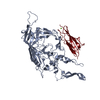
|
|---|---|
| 1 | x 60
|
| 2 |
|
| 3 | x 5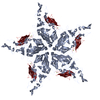
|
| 4 | x 6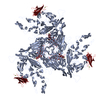
|
| 5 | 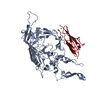
|
| Symmetry | Point symmetry: (Schoenflies symbol: I (icosahedral)) |
- Components
Components
| #1: Protein | Mass: 31837.385 Da / Num. of mol.: 1 / Fragment: residues 311-597 Source method: isolated from a genetically manipulated source Source: (gene. exp.)  Homo sapiens (human) / Gene: KIAA0319L, AAVR, KIAA1837, PP791 / Plasmid: pET-11a / Production host: Homo sapiens (human) / Gene: KIAA0319L, AAVR, KIAA1837, PP791 / Plasmid: pET-11a / Production host:  |
|---|---|
| #2: Protein | Mass: 82077.445 Da / Num. of mol.: 1 Source method: isolated from a genetically manipulated source Source: (gene. exp.)  Adeno-associated virus - 2 / Gene: VP1 / Cell line (production host): Sf9 / Production host: Adeno-associated virus - 2 / Gene: VP1 / Cell line (production host): Sf9 / Production host:  |
| #3: Chemical | ChemComp-MG / |
| #4: Water | ChemComp-HOH / |
| Has protein modification | Y |
-Experimental details
-Experiment
| Experiment | Method: ELECTRON MICROSCOPY |
|---|---|
| EM experiment | Aggregation state: PARTICLE / 3D reconstruction method: single particle reconstruction |
- Sample preparation
Sample preparation
| Component |
| |||||||||||||||||||||
|---|---|---|---|---|---|---|---|---|---|---|---|---|---|---|---|---|---|---|---|---|---|---|
| Molecular weight |
| |||||||||||||||||||||
| Source (natural) |
| |||||||||||||||||||||
| Source (recombinant) |
| |||||||||||||||||||||
| Details of virus |
| |||||||||||||||||||||
| Natural host |
| |||||||||||||||||||||
| Virus shell |
| |||||||||||||||||||||
| Buffer solution | pH: 7.4 | |||||||||||||||||||||
| Buffer component |
| |||||||||||||||||||||
| Specimen | Conc.: 0.1 mg/ml / Embedding applied: NO / Shadowing applied: NO / Staining applied: NO / Vitrification applied: YES Details: Virus-like particles at 0.10 mg/mL were adhered to thin continuous carbon-coated grids, then, after initial blotting, AAVR-PKD1-2 was added at 0.74 mg/mL (a 10-fold molar excess over AAV2 ...Details: Virus-like particles at 0.10 mg/mL were adhered to thin continuous carbon-coated grids, then, after initial blotting, AAVR-PKD1-2 was added at 0.74 mg/mL (a 10-fold molar excess over AAV2 subunits) before blotting again. | |||||||||||||||||||||
| Specimen support | Details: Glow discharge settings: Pelco easiGlow, 25s, 25mA, 0.39mBar, negative polarity Grid: Ted Pella Cat#01824, ultrathin carbon film (<3nm) on lacey carbon support film Grid material: COPPER / Grid mesh size: 400 divisions/in. | |||||||||||||||||||||
| Vitrification | Instrument: FEI VITROBOT MARK IV / Cryogen name: ETHANE / Humidity: 100 % / Chamber temperature: 298.15 K Details: 4ul of AAV-2 (1.7uM) was added to the grid, followed by 4ul of AAVR-PKD1-2 (16.7uM), with manual blotting after each addition with Whatman paper (Cat. no. 1001-110.) 4ul of buffer containing ...Details: 4ul of AAV-2 (1.7uM) was added to the grid, followed by 4ul of AAVR-PKD1-2 (16.7uM), with manual blotting after each addition with Whatman paper (Cat. no. 1001-110.) 4ul of buffer containing 25mM HEPES, 150mM NaCl, pH 7.4 was added to the grid before final blotting and plunge-freezing in the Vitrobot (blot time 1.5sec, blot force -1). |
- Electron microscopy imaging
Electron microscopy imaging
| Experimental equipment |  Model: Titan Krios / Image courtesy: FEI Company |
|---|---|
| Microscopy | Model: FEI TITAN KRIOS |
| Electron gun | Electron source:  FIELD EMISSION GUN / Accelerating voltage: 300 kV / Illumination mode: FLOOD BEAM FIELD EMISSION GUN / Accelerating voltage: 300 kV / Illumination mode: FLOOD BEAM |
| Electron lens | Mode: BRIGHT FIELD / Nominal magnification: 75000 X / Nominal defocus max: -2000 nm / Nominal defocus min: -800 nm / Cs: 2.7 mm / Alignment procedure: COMA FREE |
| Specimen holder | Cryogen: NITROGEN / Specimen holder model: FEI TITAN KRIOS AUTOGRID HOLDER |
| Image recording | Average exposure time: 40 sec. / Electron dose: 25.4 e/Å2 / Detector mode: SUPER-RESOLUTION / Film or detector model: FEI FALCON III (4k x 4k) / Num. of grids imaged: 1 / Num. of real images: 2329 |
| Image scans | Width: 7676 / Height: 7420 |
- Processing
Processing
| EM software |
| ||||||||||||||||||||||||||||||||||||||||||||||||||
|---|---|---|---|---|---|---|---|---|---|---|---|---|---|---|---|---|---|---|---|---|---|---|---|---|---|---|---|---|---|---|---|---|---|---|---|---|---|---|---|---|---|---|---|---|---|---|---|---|---|---|---|
| CTF correction | Type: PHASE FLIPPING AND AMPLITUDE CORRECTION | ||||||||||||||||||||||||||||||||||||||||||||||||||
| Particle selection | Num. of particles selected: 34450 Details: RELION Autopicker using 3D AAV-2 reference filtered to 20A with 15 degree sampling | ||||||||||||||||||||||||||||||||||||||||||||||||||
| Symmetry | Point symmetry: I (icosahedral) | ||||||||||||||||||||||||||||||||||||||||||||||||||
| 3D reconstruction | Resolution: 2.4 Å / Resolution method: FSC 0.143 CUT-OFF / Num. of particles: 21373 / Num. of class averages: 1 / Symmetry type: POINT | ||||||||||||||||||||||||||||||||||||||||||||||||||
| Atomic model building | Protocol: FLEXIBLE FIT / Space: REAL Target criteria: Map values at grid points within 2 Angstrom of atoms Details: An initial model for AAVR was constructed by homology modeling using Modeller 9.2. After remodeling AAVR and the crystal structure of AAV2, the structure was refined using RSRef embedded in ...Details: An initial model for AAVR was constructed by homology modeling using Modeller 9.2. After remodeling AAVR and the crystal structure of AAV2, the structure was refined using RSRef embedded in CNS for stereochemically restrained torsion angle simulated annealing and gradient descent optimization. Stand-alone RSRef was used for refinement of EM envelope corrections, resolution estimates, and restrained atomic B-factors. | ||||||||||||||||||||||||||||||||||||||||||||||||||
| Atomic model building | PDB-ID: 1LP3 Pdb chain-ID: A / Accession code: 1LP3 / Pdb chain residue range: 217-735 / Source name: PDB / Type: experimental model |
 Movie
Movie Controller
Controller





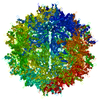
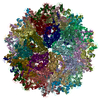
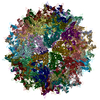
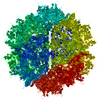
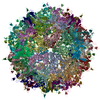
 PDBj
PDBj
